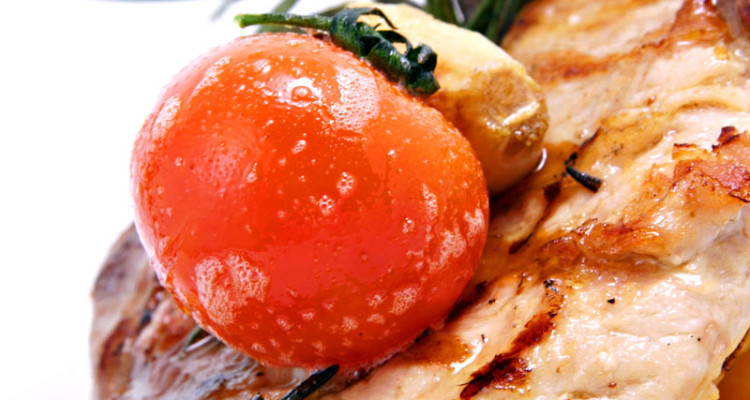I don’t like boneless skinless chicken breasts (let’s call them BSCBs for short, okay?). I know they’re are supposed to be a staple of all athletes’ kitchens, but mine always end up dry or tasteless (or both). Admit it: Yours do too, but you rescue it with a sauce or by shaking one of your fancy pants gourmet rubs all over it. Deep inside, your soul cries out to join me in saying: GOD SAVE US ALL FROM THESE AWFUL CHICKEN BREASTS.
Do not abandon hope, ye chicken faithful. The reason why BSCBs are the world’s most temperamental proteins is precisely because we’ve taken out all the things that help keep the juiciness in. Take a little mental inventory here—if you do have a BSCB recipe that you can actually stand, does it include searing in a bunch of olive oil? Does it include a sauce made with (gasp!) fat in it? Here’s a newsflash: if you start cooking breasts with the bone in and the skin on, you can cut out the butter/olive oil/sauce middle men and have juicy chicken.
Another way to save dinner is to stop it with the breasts and move on to the thighs. (This is all sounding pretty luscious, eh? Breasts and thighs—oh my!) In that case, go ahead with the boneless, skinless variety, which are juicy, moist and practically foolproof as a protein. And despite its bad rep as having more fat than white meat (which is true), dark meat has more iron, zinc and vitamins. Oh, and a 2012 New York University study found that dark meat contains a nutrient called taurene—absent in the breast—that reduced heart disease risk in people with high cholesterol.
Here are two recipes to get you back to winning at dinner.
The World’s Easiest Chicken Breasts
Serves 2-4
2 pounds bone-in, skin-on chicken breast (sometimes called split chicken breast)
2-3 tablespoons olive oil
2 garlic cloves, crushed
1 teaspoon salt
1 teaspoon pepper
Preheat oven to 450 degrees. Rinse the chicken and pat dry. Set aside and stir together all other ingredients until well combined (I did mine in a small food processor). Gently rub the garlic and oil mixture underneath the skin and then on top of the skin (you may need to tug a bit or use your hand to get that membrane that attaches the skin to the meat to let go). Sprinkle with a little extra salt and pepper. Bake for 30 to 35 minutes. To remove the bone, turn the chicken on its side, with the rib bone protrusion facing up. Using that as a guide, slice down between the bone and the breast.
PRO TIP: I’ve used about a million different ingredients to jazz this up. A couple tablespoons of pesto under the breast; some blended up olives and lemon for a Greek feel. But it always works better to keep the moist stuff under the skin and just put oil and dry spices on top.
***
If you don’t like a good rotisserie chicken, you’re probably vegan. Here I’ve created a way to get all the taste of the rotisserie without having to go the takeout route.
Rotisserie–Rrub Chicken Thighs
Serves 6
6 pounds of boneless, skinless chicken thighs
1 teaspoon seasoned salt (Lawry’s is my favorite)
1 teaspoon onion powder
½ teaspoon poultry seasoning
½ teaspoon paprika
1 teaspoon salt
1 teaspoon pepper
Juice from ½ a lemon
Combine all the dry ingredients into a rub, mixing well to combine. Squirt the thighs with half a lemon over the thighs, and then toss with the dry rub, reserving a little to rub to sprinkle on top. Arrange in the slow cooker with the smooth side up, sprinkle them with the remaining rub and cook on low for about 2-4 hours (crockpot temperatures can vary) or until the meat registers 165 with a meat thermometer.
Oven directions: Heat oven to 425 degrees. Prepare thighs as above, making sure rub gets on all sides of the meat. In a high-sided baking dish, arrange thighs, smooth side up. Bake for 20 minutes or until chicken comes to temperature.
NOTE: To get that not-too-wet, not-too-dry rotisserie consistency, you’ll have to remove some of the drippings. Thighs release a lot of juice—perfect for gravy if that’s your style—but it can make the thighs super soupy and I want my thighs firm (is that so wrong?). I use my baster to remove all the drippings when the cook time is done, then let the thighs sit on warm or low for another half hour or so.

